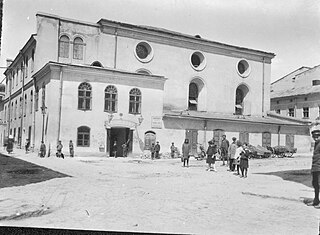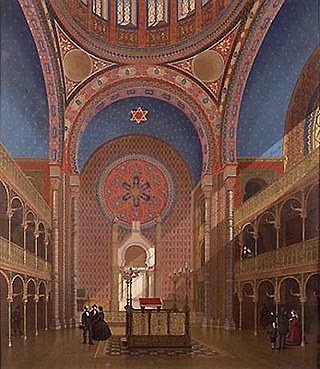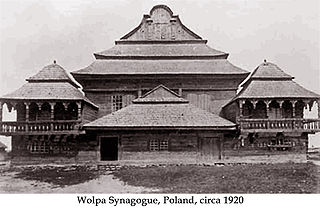
A synagogue, also called a shul or a temple, is a place of worship for Jews and Samaritans. It has a place for prayer where Jews attend religious services or special ceremonies such as weddings, b'nai mitzvah, choir performances, and children's plays. They also have rooms for study, social halls, administrative and charitable offices, classrooms for religious and Hebrew studies, and many places to sit and congregate. They often display commemorative, historic, or modern artwork alongside items of Jewish historical significance or history about the synagogue itself.

Synagogue architecture often follows styles in vogue at the place and time of construction. There is no set blueprint for synagogues and the architectural shapes and interior designs of synagogues vary greatly. According to tradition, the Shekhinah or divine presence can be found wherever there is a minyan, a quorum, of ten. A synagogue always contains an Torah ark where the Torah scrolls are kept, called the aron qodesh by Ashkenazi Jews and the hekhal by Sephardic Jews.

Zamość Synagogue is a UNESCO-protected Renaissance synagogue built between 1610 and 1618 in Zamość, southeastern Poland. Erected during the times of the Polish–Lithuanian Commonwealth, it functioned as a place of worship for Polish Jews until World War II, when the Nazis turned the interior into a carpenters' workshop. The structure was spared from destruction and in 1992 it became a UNESCO World Heritage Site alongside the Old City of Zamość.

The Ibn Danan Synagogue is a synagogue in Fes, Morocco, dating from the 17th century. The synagogue is located in the Mellah district within Fes el-Jdid, one of the components of the historic medina of Fes.

The Great Suburb Synagogue was a synagogue at Bożnicza-Street 16 in Lviv, in the Lviv Oblast of Ukraine. The synagogue was developed in stages, with the men's prayer hall completed in 1632, located in what was then the Polish–Lithuanian Commonwealth. The synagogue was destroyed by Nazi Germany in 1941 and the ruins dismantled during the late 1940s.

The Synagogue in Chachmei Lublin Yeshiva is a synagogue located in Lublin, Poland, in the building of Chachmei Lublin Yeshiva, on Lubartowska 85 Street.

The Synagogue in Glockengasse was a synagogue in Cologne built to the plans of the architect of the Cologne Cathedral, Ernst Friedrich Zwirner. It was built on the previous Monastery of St. Clarissa, where a modest hall of prayer had been erected in the years of the French occupation and had been closed in 1853 because it was unsafe.

The Włodawa Synagogue in Włodawa, Poland is an architectural complex consisting of two historic synagogues and a Jewish administrative building, now preserved as a museum. The complex includes the Włodawa Great Synagogue of 1764–74, the late 18th century Small Synagogue, and the 1928 community building. It is "one of the best-preserved" synagogues in Poland.

Córdoba Synagogue is a historic edifice in the Jewish Quarter of Córdoba, Spain, built in 1315. The synagogue's small size points to it having possibly been the private synagogue of a wealthy man. It is also possible that Córdoba's complex of buildings was a yeshivah, kollel, or study hall. Another possibility is that this was the synagogue of a trade guild, which converted a residence or one of the work rooms into the synagogue. The synagogue was decorated according to the best Mudejar tradition.

Wooden synagogues are an original style of vernacular synagogue architecture that emerged in the former Polish–Lithuanian Commonwealth. The style developed between the mid-16th and mid-17th centuries, a period of peace and prosperity for the Polish-Lithuanian Jewish community. While many were destroyed during the First and Second World Wars, there are some that survive today in Lithuania.

The Łańcut Synagogue is a Baroque synagogue in Łańcut, Poland. The Łańcut Synagogue is a rare surviving example of the vaulted synagogues with a bimah-tower, that were built throughout the Polish lands in masonry from the sixteenth through the early nineteenth centuries.

The Przedbórz Synagogue was a wooden synagogue in Przedbórz, Poland.

The Wołpa Synagogue was a synagogue located in the town of Voŭpa, in what is now western Belarus. It was reputed to be the "most beautiful" of the wooden synagogues of the former Polish–Lithuanian Commonwealth, a "masterwork" of wooden vernacular architecture.

The Plymouth Synagogue is a synagogue in the city of Plymouth, England and the home of the Plymouth Hebrew Congregation. Built in 1762, it is a listed Grade II* building and the oldest extant synagogue built by Ashkenazi Jews in the English speaking world.

The Canton Synagogue is one of five synagogues in the Jewish Ghetto of Venice, Italy. Established only four years after the nearby Scuola Grande Tedesca (1528), it is the second oldest Venetian synagogue. Its origins are uncertain: it might have been constructed as a prayer room for a group of Provençal Jews soon after their arrival in Venice, or as a private synagogue for a prominent local family. Repeatedly remodeled throughout its history, its interior is predominantly decorated in the Baroque and Rococo styles.

Pohrebyshche Synagogue was a former Jewish synagogue, located in Pohrebyshche, a town in Vinnytsia Oblast, Ukraine. The wooden synagogue was built in 1690, to replace an earlier synagogue, and was destroyed by German Nazis during World War II.

The Synagogue in Sataniv, a town in Khmelnytskyi Oblast in Ukraine was built in 1514, which probably makes it the oldest existing synagogue in Ukraine.

The Great Synagogue was a former Jewish synagogue, located in Pidhaitsi, Ternopil Oblast in Ukraine. The congregation worshipped in the Ashkenazi rite. Built prior to 1648, the fortress synagogue was abandoned during World War II, was used for grain storage thereafter, then as a ruin before its collapse in 2019 and subsequent demolition.

The Great Synagogue or Choral Synagogue is a former Orthodox Jewish synagogue, located on Yaroslava Mudroho Street, in Bila Tserkva, in the Kyiv Oblast of Ukraine. The synagogue was built in the former Russian Empire in 1860 and the congregation worshipped in the Ashkenazi rite.

The Synagogue of Čekiškė is a former synagogue in Čekiškė, Kaunas District Municipality, Lithuania.




















